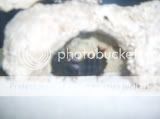Koshmar
The Hardy Mongolian Pony
Thanks Roy.
I apprieciate being able to get an answer from a professional.
Should I be concerned if the white portions do not clear up?
Also I noticed that air bubbles appeared to be comming from her, not a lot but a bubble or two when she swam and moved around earlier.
I apprieciate being able to get an answer from a professional.
Should I be concerned if the white portions do not clear up?
Also I noticed that air bubbles appeared to be comming from her, not a lot but a bubble or two when she swam and moved around earlier.



